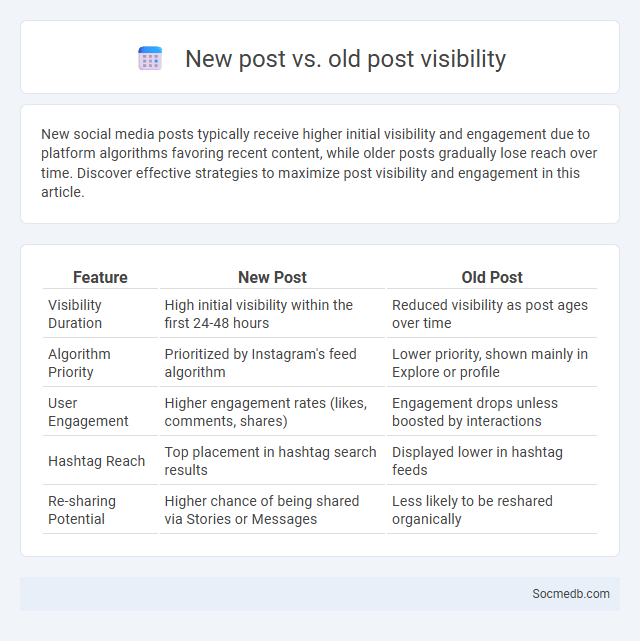
Photo illustration: New post vs Old post visibility
New social media posts typically receive higher initial visibility and engagement due to platform algorithms favoring recent content, while older posts gradually lose reach over time. Discover effective strategies to maximize post visibility and engagement in this article.
Table of Comparison
| Feature | New Post | Old Post |
|---|---|---|
| Visibility Duration | High initial visibility within the first 24-48 hours | Reduced visibility as post ages over time |
| Algorithm Priority | Prioritized by Instagram's feed algorithm | Lower priority, shown mainly in Explore or profile |
| User Engagement | Higher engagement rates (likes, comments, shares) | Engagement drops unless boosted by interactions |
| Hashtag Reach | Top placement in hashtag search results | Displayed lower in hashtag feeds |
| Re-sharing Potential | Higher chance of being shared via Stories or Messages | Less likely to be reshared organically |
Introduction: The Battle Between New and Old Posts
Social media platforms continuously balance the visibility between new and older posts to maintain user engagement and content relevance. Algorithms prioritize fresh content to keep feeds dynamic while integrating popular older posts to enhance user experience through proven interest. This strategic interplay influences content reach and audience interaction, shaping the overall platform dynamics.
Understanding Platform Algorithms: How Visibility Is Determined
Social media platform algorithms prioritize content based on user engagement metrics such as likes, comments, shares, and time spent on posts, directly influencing visibility. Factors like relevance, recency, and user preferences are analyzed to curate personalized feeds, boosting content that aligns with individual behaviors. Understanding these algorithmic criteria enables creators to optimize posting strategies and enhance reach effectively.
Freshness Factor: Why New Posts Get Initial Boost
New posts on social media platforms receive an initial boost due to the Freshness Factor, which algorithms prioritize to ensure timely and relevant content reaches users quickly. This boost helps gauge user engagement metrics like likes, comments, and shares, signaling the post's relevance for extended visibility. Platforms such as Instagram, Facebook, and Twitter leverage this approach to keep feeds dynamic and encourage real-time interactions.
Evergreen Content: How Old Posts Maintain Visibility
Evergreen content on social media ensures your posts remain relevant and continue to attract engagement long after the initial publish date by addressing timeless topics or providing valuable information. This type of content consistently appears in search results and feeds, maintaining visibility without frequent updates. You can enhance your social media strategy by creating and sharing evergreen posts that drive steady traffic and sustained audience interaction over time.
Algorithmic Ranking Signals: Key Drivers of Content Placement
Algorithmic ranking signals crucially influence your content's visibility on social media platforms by determining how posts are prioritized in user feeds. Factors such as engagement rates, relevance, and user behavior patterns help algorithms decide which content appears first, driving higher interaction and reach. Optimizing content to align with these signals enhances placement, ensuring your message reaches a targeted audience more effectively.
Engagement Metrics: Their Role in Post Ranking
Engagement metrics, including likes, comments, shares, and click-through rates, are crucial indicators that social media algorithms use to rank posts. Higher engagement signals to platforms like Facebook and Instagram that content resonates with Your audience, increasing its visibility and reach. Optimizing content to boost these metrics directly influences Your post's prominence in users' feeds, driving greater interaction and brand awareness.
Temporal Decay: How Algorithms Prioritize Recency
Social media algorithms prioritize content based on temporal decay, where newer posts receive more visibility and engagement opportunities than older ones. This recency bias ensures that feeds remain fresh and relevant, encouraging continuous user interaction. Platforms like Facebook, Instagram, and Twitter use this strategy to surface trending topics and recent updates, enhancing real-time content discovery.
Strategies to Boost Old Post Visibility
Reviving old social media posts can significantly increase your content's reach and engagement by leveraging strategic techniques such as updating the post with fresh information, using relevant hashtags, and resharing it during peak user activity times. Incorporating targeted keywords and engaging visuals enhances the post's visibility in search results, while interacting with comments reignites conversation and attracts new viewers. Your consistent effort in optimizing and promoting archived content ensures sustained audience interest and maximizes the value of previously created posts.
Balancing Content Calendar: New vs. Repurposed Posts
Balancing your social media content calendar with a mix of new and repurposed posts enhances engagement while maximizing resource efficiency. New content attracts followers with fresh ideas and timely updates, whereas repurposed posts reinforce key messages and extend the lifespan of successful material. Your strategic blend ensures consistent audience interaction without overwhelming your content creation capacity.
Future Trends: Evolving Algorithms and Content Visibility
Future trends in social media highlight evolving algorithms prioritizing personalized content delivery to enhance user engagement and retention. Machine learning advancements enable platforms like Instagram and TikTok to refine content visibility, ensuring more relevant and timely posts appear in user feeds. These algorithmic changes drive marketers to adopt dynamic strategies, optimizing content for algorithm signals such as dwell time, interaction rates, and user intent.
 socmedb.com
socmedb.com